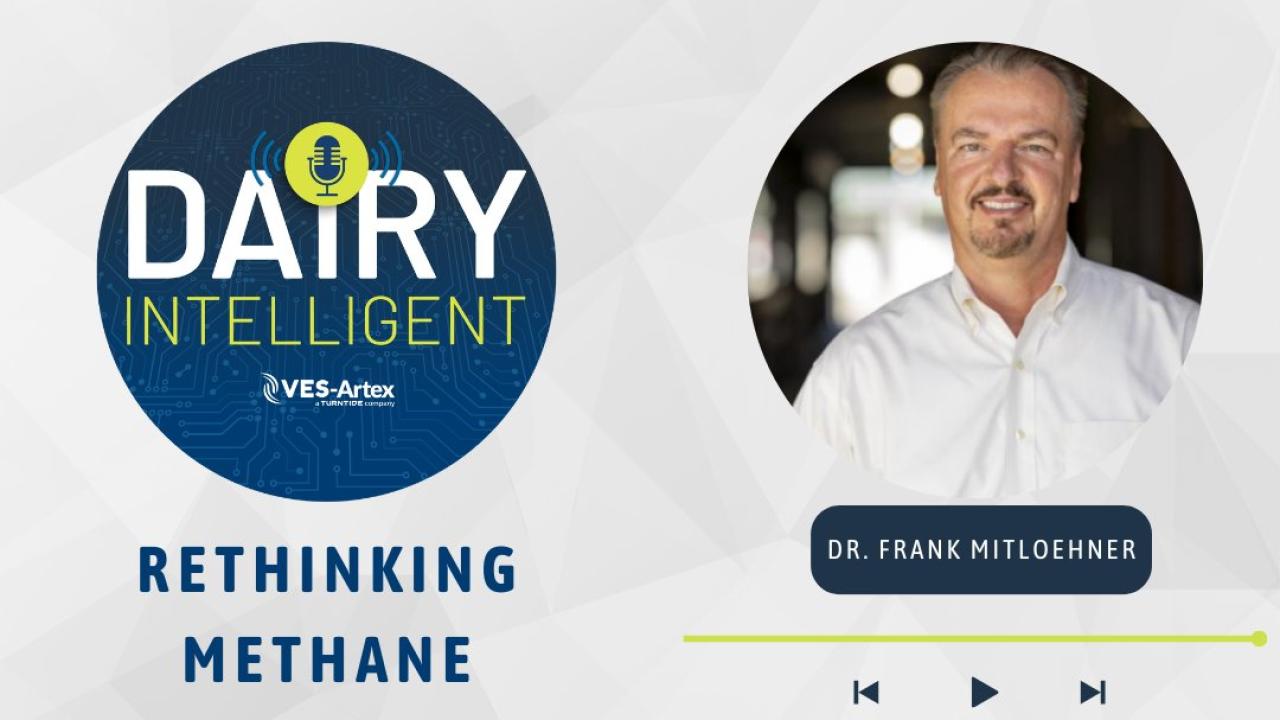
Dr. Frank Mitloehner Joins the Dairy Intelligent Podcast to Discuss How Animal Agriculture Can Be Part of a Climate Solution
Rethinking methane with UC Davis professor and CLEAR Center director
The UC Davis CLEAR Center’s Dr. Frank Mitloehner spoke on the Dairy Intelligent podcast in an episode called Rethinking Methane. Dr. Mitloehner explained how methane warms our atmosphere differently than other greenhouse gases, and how rethinking methane's role in our atmosphere reveals that animal agriculture can feasibly be on the path to climate neutrality.
The three main greenhouse gases are carbon dioxide, methane, and nitrous oxide, and they differ in how they warm the planet. Carbon dioxide is the most abundant greenhouse gas and is mainly produced by the use of fossil fuels. Methane is produced by swamps and ruminant livestock and is about 30 times more powerful per molecule at trapping heat than carbon dioxide. Nitrous oxide comes from nitrogen fertilizers and is 265 times more potent per molecule in trapping heat than carbon dioxide.
While nitrous oxide is the most potent of the greenhouse gases, methane has been at the center of conversations around reducing global warming. In contrast to the other greenhouse gases, methane is naturally destroyed within 12 years which is why it is important to quantify greenhouse gases differently based on their role and lifespan in the atmosphere.
Methane produced by the livestock sector starts in the atmosphere as atmospheric carbon dioxide. Plants photosynthesize this carbon dioxide to produce cellulose and starch. Ruminants eat these carbohydrates, convert them into methane, and belch the methane out into the atmosphere. The methane stays in the atmosphere for around 12 years and then is destroyed in a process called oxidation, where the methane becomes carbon dioxide again. Methane cycles through the atmosphere from carbon dioxide to carbohydrates to methane and then back to carbon dioxide. Conversely, carbon dioxide produced from burning fossil fuels is not destroyed and stays in the atmosphere for hundreds to a thousand years. The burning of fossil fuels adds additional carbon to the atmosphere, whereas methane production from ruminants cycles carbon that already exists in the atmosphere.
Although methane cycles through the atmosphere every 12 years, it is still potent enough to warrant concern about its effects on global warming.The livestock sector is one of two sectors in society that has the opportunity to mitigate climate change, and thus has a responsibility to reduce methane and thus reduce warming.
Animal agriculture is often blamed for climate change and methane emissions. The UN FAO’s report “Livestock’s Long Shadow” incorrectly stated that animal agriculture produced more methane emissions than the entire global transportation sector. Dr. Mitloeher showed that two different methodologies were used to measure methane emissions from each sector. Although the report was corrected, the incorrect information still spread and created the misconception that animal agriculture is a leading cause of global warming.
Critics of animal agriculture might use outdated facts or misleading statistics to make their point. Critics may point to global emissions when discussing the U.S. livestock sector. Globally, animal agriculture emits about 14.5% of greenhouse gases, but when discussing U.S. emissions animal agriculture makes up about 4% of direct U.S. emissions and about .5% of global emissions.
With the most dairy cows in the United States, California is the center of the conversation around livestock methane emissions. Worldwide, California is leading the way in incentive-based programs to reduce methane emissions. Methane law SB1383 mandates that all sources of methane must reduce their methane emissions by 40% by 2030 using 2013 baselines. California is helping producers to meet these goals by financially incentivising methane reductions. The State partners with the dairy industry to install covered manure lagoons, called anaerobic digesters, which trap methane gas emitted from manure and convert it into a fuel used for transportation. This process is so carbon negative that the installation of these digesters makes not only environmental sense but financial sense for producers.
The carbon credit market provides an additional financial incentive for producers to reduce their methane emissions. Farmers are paid for their captured methane in low carbon fuel standard credits. Companies wanting to reduce their own carbon footprint can purchase these carbon credits from dairies.
California’s goal for reducing methane in the dairy sector is 7.2 MMTCO2e, and dairies have already reduced 2.2 MMTCO2e, meaning 30% of the reduction goal has already been met by voluntary, incentive-based measures. In addition to manure technologies, other tools to reduce methane emissions are in the works. Feed additives are added to rations of cow feed that help reduce enteric emissions by up to 40%. A genetic trait for methane has also been identified to allow for selective breeding for low methane producing cows. Another way to reduce methane is by inserting a bolus into the rumen of a cow to slowly release an active ingredient that reduces methane production. Additionally, a methane vaccine is under development as well. In addition to these tools, any improvement in efficiency and productivity has a positive impact on the environment.
Dr. Mitloehner stressed the fact that methane offers an opportunity for the livestock sector to reduce global warming and that the high energetic value of methane shouldn't be wasted.
“Methane is a problem if we don’t manage it, but if we do manage it and we harness it from the manure, or we reduce it from escaping through the mouth, then we can convert something that was a liability before into an asset.”
You can listen to the podcast here.
